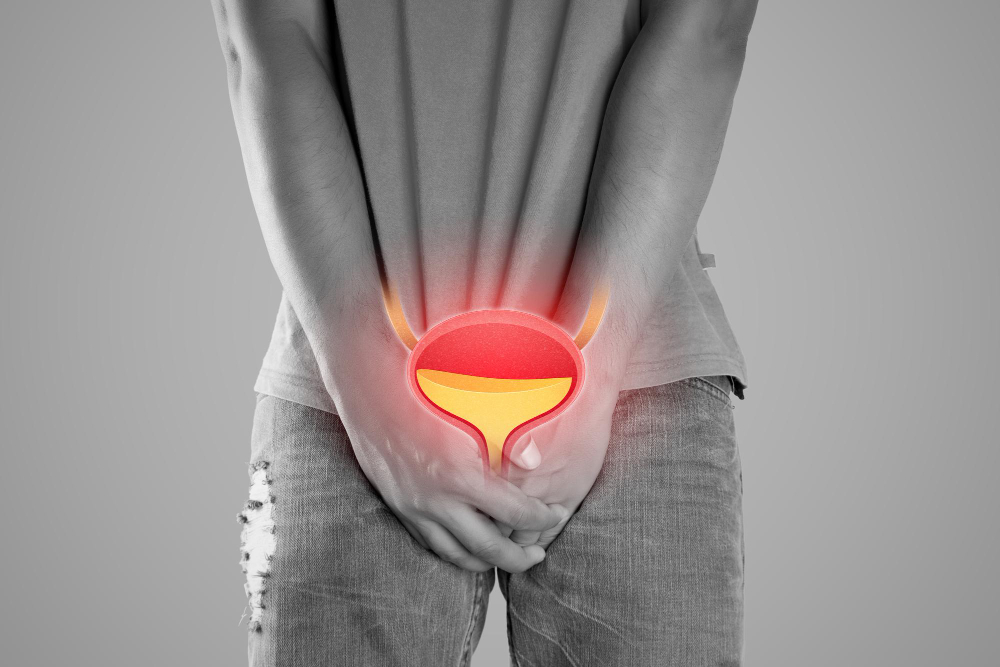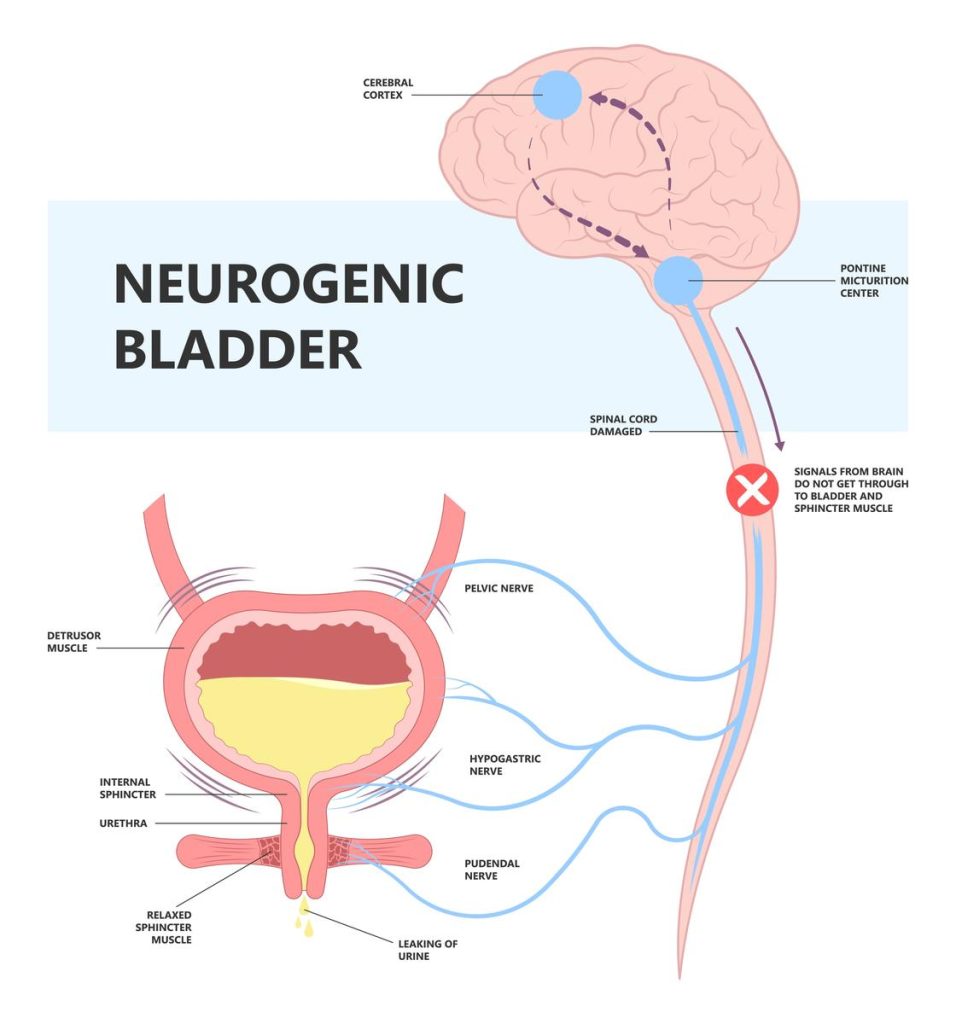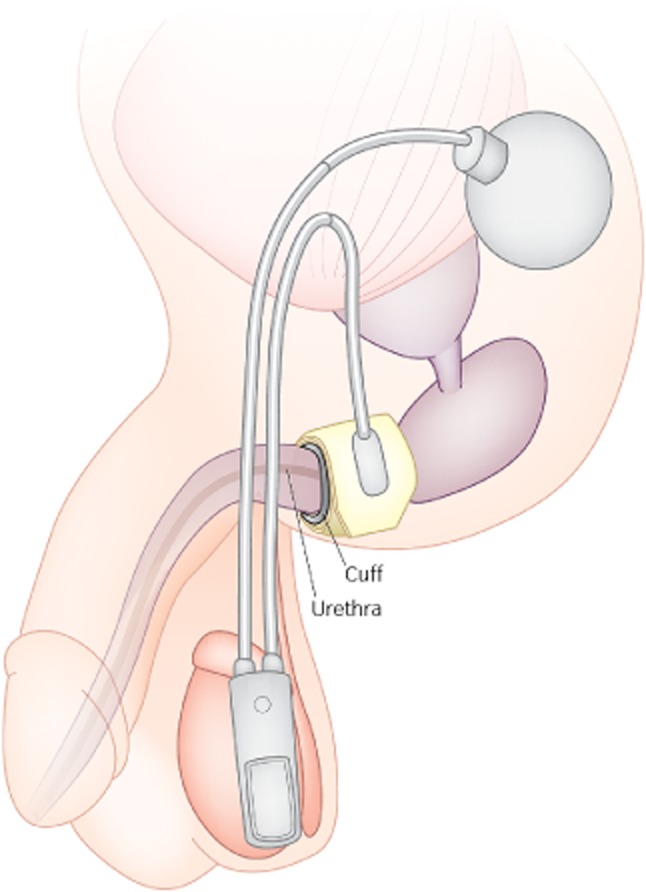Neurogenic Bladder

Neurogenic bladder occurs when there is an interruption in the connection between the nervous system and bladder function due to injury or illness. Although it cannot be cured, it can be effectively controlled. Ways to manage this condition include taking prescribed medications, utilizing catheters, and making necessary adjustments to one’s lifestyle.

The Urinary System
The urinary system includes the bladder and kidneys, which play a role in creating, storing, and eliminating urine. In a healthy urinary system, the kidneys produce urine and transfer it to the bladder. The bladder is a balloon-like organ located in the lower belly, supported by pelvic muscles, and it functions as a container for urine.
In its relaxed state, the bladder is not filled with urine. Nerve signals in the brain inform you when your bladder is becoming full, resulting in the sensation of needing to urinate. The brain then instructs the bladder muscles to squeeze or contract, which results in the expulsion of urine through the urethra, the tube responsible for carrying urine out of the body. To prevent any leakage before you are prepared to use the restroom, the urethra is equipped with sphincter muscles that remain closed. These sphincters open when the bladder contracts.
How common is neurogenic bladder?
Neurogenic bladder dysfunction is a prevalent issue among individuals who have suffered spinal cord injuries, impacting over 90% of them. A significant majority, around 95%, of people with spina bifida also experience neurogenic bladder dysfunction. Additionally, this condition affects a substantial percentage, ranging from 50% to 80%, of individuals with multiple sclerosis. People with conditions like stroke, Parkinson’s disease, and various other nervous system disorders are also susceptible to neurogenic bladder. Furthermore, nerve-damaging conditions such as advanced diabetes can also lead to neurogenic bladder.
Causes
For your bladder to retain urine until you are prepared to release it, various muscles and nerves need to cooperate. Messages travel between the brain and the muscles responsible for controlling bladder emptying. In situations where these nerves are affected by illness or injury, the muscles may not be capable of contracting or relaxing at the appropriate moments.
Neurogenic bladder is a condition where the coordination between nerves and muscles is impaired, leading to improper functioning. This can cause issues in both filling and emptying the bladder. In the case of overactive bladder (OAB), the muscles may become excessively active and contract more frequently than usual, even before the bladder is completely filled with urine. Additionally, weak sphincter muscles may result in urine leakage before one is prepared to use the restroom, which is known as incontinence.
Some individuals may have a bladder muscle that is not active enough. This means that when the bladder is filled with urine, it does not contract to empty the bladder completely or not at all. Additionally, the muscles surrounding the urethra, known as the sphincter muscles, may not function properly. These muscles may remain tense when attempting to empty the bladder. There are also individuals who may experience both an overactive and underactive bladder.

Neurogenic Bladder and Urinary Tract Infections
It is important to learn how to identify the signs of urinary infections (UTIs) in order to prevent a localized bladder issue from developing into a broader infection. Recognizing symptoms like a burning sensation while urinating, fever, pain in the lower back on one side, and a heightened frequency of urination can help reduce urinary discomfort and address the infection effectively.
For individuals who are at risk of urinary infections, various supplements and medications can be used to prevent these infections. This can include supplements made from cranberries, as well as medications like mandelamine that help stop bacterial growth. Additionally, specific vitamins may also be recommended for these patients.
Patients suffering from a neurogenic bladder may require the use of a urinary catheter. This is a slender tube that is inserted into the bladder through the regular urine passage, known as the urethra. Depending on the situation, patients may have a catheter in place continuously, known as an indwelling catheter, or they may be trained to self-administer intermittent catheterization. This means they would insert a catheter into the bladder multiple times a day, usually around 4 to 6 times, to ensure the bladder is emptied properly if the patient is unable to do so on their own.
How is neurogenic bladder diagnosed?
If your healthcare provider suspects that you may have a neurogenic bladder, they will examine your brain, spinal cord, and bladder to confirm the diagnosis. They will also assess your medical history and conduct a physical examination. Additional tests may be conducted as well.
- Skull and spine X-rays capture images of tissues, bones, and organs by utilizing unseen energy beams.
- Imaging tests of the bladder and ureters
- Ultrasound, also known as sonography, is a medical procedure that utilizes high-frequency sound waves in order to produce visual representations of organs on a computer monitor.
- During a cystoscopy, a slender and flexible tube with a viewing instrument is inserted by a medical professional into the urethra in order to inspect the urinary system. This procedure aims to detect any alterations or obstructions, such as tumors or stones.
- Examinations like urodynamics, which require filling the bladder, assess its capacity and determine whether it completely voids.
How is neurogenic bladder treated?
Your healthcare provider will collaborate with you to determine a suitable course of action for addressing the cause of neurogenic bladder. Various treatment options for neurogenic bladder may be considered, such as:
- Changing your lifestyle can involve avoiding foods and beverages that can cause irritation to your bladder, such as alcohol, coffee, and soda. Additionally, effectively managing blood glucose levels for individuals with diabetes and addressing constipation issues can also be beneficial.
- Clean intermittent catheterization (CIC) involves using slim and flexible tubes inserted into the urethra to reach the bladder and remove urine. This technique allows individuals to be self-sufficient in emptying their bladder according to their own preferred timing.
- Continuous catheterization involves the constant wearing of a catheter, which is a small tube that can be inserted either through the urethra or the lower abdominal wall (suprapubic tube).
- Drugs Medications used for the treatment of neurogenic bladder comprise oxybutynin, tolterodine, mirabegron, solifenacin succinate, and various others.
- Your healthcare provider administers injections of Botox, which contain botulinum A toxin, into your bladder or urinary sphincters.
- Sphincter resection involves the removal of the weakened part of the muscle in the urethral sphincter. In certain situations, a procedure called sphincterotomy may be done, which involves cutting the entire muscle.
- The artificial sphincter is a device used to assist with the treatment of serious urinary incontinence. It is utilized when the muscle responsible for controlling the urethra is not functioning properly. In order to install the sphincter, surgery is necessary to place a cuff around the urethra. Additionally, a pump is positioned underneath the skin in the scrotum or labia. This pump is utilized to open the sphincter and enable the passage of urine.
- Bladder augmentation, or augmentation cystoplasty, involves the removal of portions of the intestine (specifically the sigmoid colon) and connecting them to the bladder walls. By doing so, this surgery reduces the internal pressure of the bladder and enhances its capacity for urine storage.
- In urinary diversion surgery, a surgeon will make an incision in the abdomen and create a stoma. This stoma can be used to either insert a catheter for draining the bladder, or an external pouch is attached to collect and contain the urine.

Products such as absorbent underwear, sanitary pads, panty liners, panty shields, and adult diapers can effectively prevent both wetness and odors while providing protection to the skin and garments. Additionally, bed pads serve to safeguard sheets and mattresses.
When to Contact a Medical Professional?
Call your health care provider if you:
- Are unable to empty your bladder at all
- Exhibit symptoms of a urinary tract infection, such as having a high body temperature, experiencing a painful sensation during urination, and needing to urinate more often than usual.
- Urinate small amounts, frequently
- Do you experience distress due to your urination habits, which consequently impacts your overall daily well-being?
Treatment in Türkiye:
The medical staff of surgical teams, doctors and consultants in Rehab Türk can provide the best treatment options and free consultations – by striving to keep abreast of the latest medical technologies and methods.
